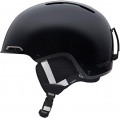Type
The type determines the category of users for which the helmet is designed.
-
Men. Helmets designed primarily for men. At the same time, the degree of specialization may vary: for example, some models are designed taking into account the structural features of the male head, while others differ from “unisex” only in marketing. And the design can be different - from strict or aggressive to completely neutral, suitable for the unisex category.
—
Women. Helmets designed specifically for a female audience. They differ from men's models primarily in their characteristic design (although not always - neutrally designed models are also found here). Also, women's equipment is produced in slightly smaller sizes, and manufacturers are trying to reduce weight - women's neck muscles are somewhat weaker than men of the same build. And other features of female anatomy (for example, narrower cheeks and a pointed chin) are also often taken into account in such models.
- Unisex. Helmets for adult riders, without a “gender” and positioned as equipment that is equally suitable for both men and women - both in construction and design. The design can be both restrained and bright.
-
Kids. Helmets designed for children and teenagers - that is, users who have not yet matured enough to wear adult equipment. They differ, first of all, in their reduced s
...ize and maximally reduced weight - to minimize the excess load on the child’s neck and spine. In addition, they often have a characteristic bright design and simplified functionality.
Note that the difference between the types of “adult” helmets is extremely arbitrary and often lies not so much in the design as in the appearance. Moreover, the same model can be produced in several colour options, including neutral, and frankly “masculine” or “feminine”. In such cases, the type is indicated by which options there are more.Size
Sizes in which this helmet model is available.
A suitable size is determined primarily by the circumference of the head at its widest point, at the level of a couple of centimetres above the eyebrows. Sizes are indicated everywhere as standard —
XXS,
XS,
S,
M,
L,
XL,
XXL, etc. However, these designations may correspond to different actual helmet sizes for different manufacturers. For example, size S for one brand may be designed for a head circumference of 56 cm, and another — for 52 – 54 cm. In addition, men's and women's helmets (see "Gender and age") of the same size may also differ. Therefore, to select a helmet that is suitable for head circumference, it is best to use special tables that take into account the points described above.
Also, note that helmets of the same size can differ markedly in internal shape and other features. Therefore, when choosing, you need to take into account not only the size, but also the actual convenience — the helmet should sit tightly on the head, but not compress it.
Detachable lining
The presence of
a detachable lining in the helmet design.
The detachable lining practically does not affect the functionality and protective properties of the helmet — except that for “extreme” professional models it is considered poorly suitable, because does not provide the required high level of protection. At the same time, this feature makes it much easier to maintain the equipment: the detachable lining can be periodically washed in a regular washing machine, and it is much easier to wash/clean it by hand than a non-detachable one.
Headphone pockets
The presence in the helmet of special
pockets for headphones.
These pockets are usually found in soft ear pads (see Detachable ear pads, although they do not have to be removable to have pockets). Their purpose as a whole is obvious from the name — the helmet can be supplemented with headphones and while riding, listen to music, radio, or even tips from a partner or coach transmitted via walkie-talkie or mobile phone. We only note that pockets are often made for specific branded headphones designed specifically for helmets; anyway, the compatibility of the helmet with third-party headphones should be specified separately. Also included in this category are models equipped with built-in headsets.
It must be remembered that music and any extraneous sounds in the headphones can be distracting while riding. Therefore, it is not recommended for beginners to use this function; for safe riding with musical accompaniment, it is worth gaining some experience.
Shell material
The material from which the shell is made is the outer hard shell of the helmet.
Many modern helmets use a plastic shell - this material is lightweight, well suited for objects of complex shape, and the necessary strength can be given to it through the use of special technologies. There are different types of plastic - for example, polycarbonate and ABS are quite popular. As a rule, the strength, reliability and quality of the plastic shell directly depend on the price category of the helmet.
There are also shells made of Kevlar or carbon fibre. Such materials usually combine very high strength with low weight, but they are very expensive and said strength is rarely critical. Therefore, such shells are typical mainly for expensive professional-level helmets.
Weight
The total weight of the ski helmet.
A helmet should be as light as possible to minimize wearing discomfort. However, in the case of a plastic shell (and most models are made of plastic), weight reduction leads to a decrease in strength and reliability. This can be corrected by the use of high-end materials such as carbon, but they affect the price of the entire product accordingly. Therefore, specifically looking for the lightest helmet is justified only if you plan to ride in simple and safe conditions; in "extreme" riding, it is worth proceeding primarily from the fact that protection is more important than lightness.

